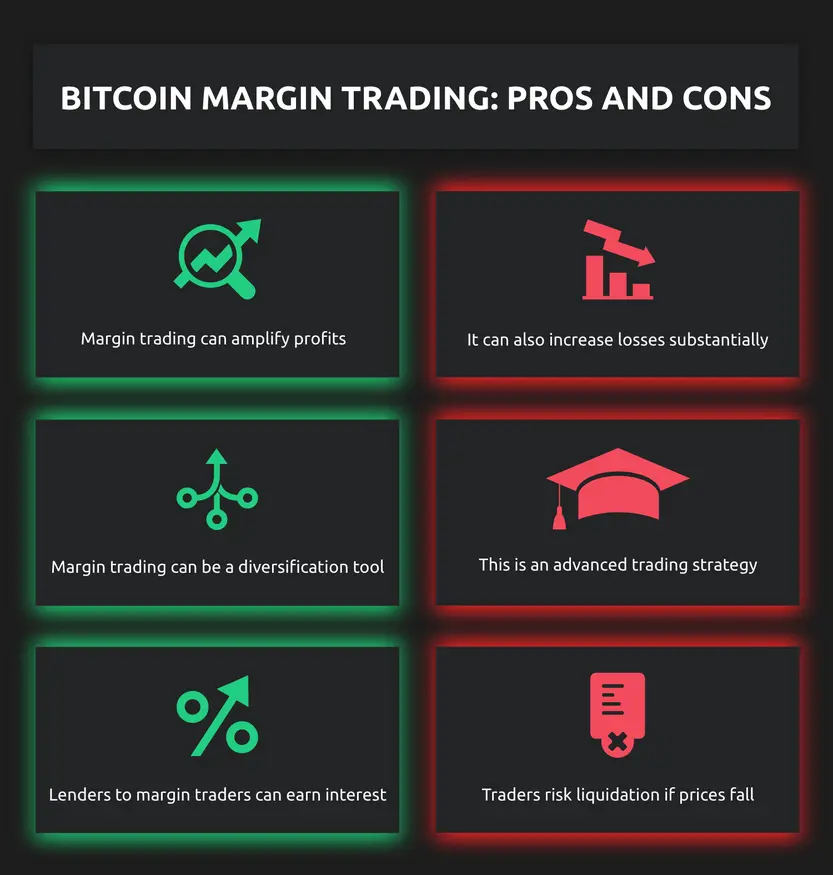Bitcoin margin trading is increasingly common – although it can amplify profits, there are some risks

Bitcoin margin trading has become increasingly available for crypto enthusiasts over recent years. Basically, this advanced strategy enables them to borrow additional funds and open larger trades.
But how does it all work, what are the advantages and disadvantages, and are there any common strategies executed by traders? Here's Bitcoin margin trading explained.
What is Bitcoin margin trading?
So… here’s how crypto margin trading works. Let’s imagine that Sophie has $1,000 of capital. Through an exchange, she chooses to open a long position on Bitcoin leveraged at a 10:1 ratio, meaning her trade is worth $10,000. In order to access these extra funds, she’s borrowed funds from other traders – and they’ll be expecting interest on top of this.
In the best-case scenario, the value of Bitcoin rises by 30 per cent. If Sophie had only traded with her original $1,000, she would have realised a profit of $300. But thanks to her Bitcoin margin trading strategies, these gains have now been amplified to $3,000 (she might be left with slightly less, once fees and interest are taken into account).
Of course, that’s assuming margin trading on Bitcoin goes well. This cryptocurrency is a highly volatile asset – and because of this, Sophie could stand to lose a substantial amount of money if she made the wrong call by going long. Let’s imagine that Bitcoin crashes soon after she’s opened the trade.
In this scenario, she would face a margin call where more funds need to be added, otherwise her position will be liquidated. The risk here is that Sophie, feeling under pressure, ends up exacerbating her losses even further by throwing good money after bad.
Bitcoin margin trading can also be used for short positions, and this could be advantageous to Sophie if she thinks that the value of this cryptocurrency is going to fall. Here, Sophie would sell $10,000 of Bitcoin with the expectation that prices tumble, and aim to buy it back at the lower price. The difference between the two is where the profit lies.
Irrespective of whether prices go up or down, lenders will be expecting their $9,000 back.
If the concept of margin trading is familiar, it is worth noting that these practices are also commonplace in the traditional finance sector. Foreign currencies are another popular market for this trading strategy, with many people speculating on fluctuations between major fiat pairings such as the British pound and the US dollar.

Bitcoin margin trading: Knowing the risks
Margin trading on Bitcoin is not something that should be entered into lightly. Ideally, you should have plenty of experience in spot trading before you embark on one of these strategies – and ensure that you have safeguards in place to protect yourself against sudden falls in the value of the underlying asset. When margin trading for the first time, it’s always worth beginning with a small position so you can understand how everything works and prevent costly mistakes.
Some platforms offer margins at much higher ratios and, as you can imagine, this will only increase the trader’s exposure if things go wrong. That’s because of how a position can be more prone to liquidation, even when there are only relatively small moves in Bitcoin’s price. Margin trading with altcoins can be even riskier, especially those which have far lower levels of liquidity than Bitcoin.
Most importantly of all, remember that margin trading is normally a short-term strategy because of how rapidly the Bitcoin markets can change. You should only allocate a small percentage of your overall portfolio, and it’s crucial to set limits that will automatically allow you to exit your position when prices dip below a certain point, or hit a high.
In some cases, you may need to go through a rigorous application process where your ability to make repayments is verified. After all, margin trading will involve you borrowing money. Some territories have also imposed limits on the maximum multiples that can be applied. In Europe, the leverage limits have been capped at 2:1 for cryptocurrencies. Enhanced verification measures, including Know Your Customer checks, can also apply.
Last but not least, the other consideration you’ll need to make involves Bitcoin margin trading taxes. Should you make a profit as a result of your activities, you’ll likely have to pay some form of capital gains tax on your returns. The policies do vary from country to country – and many nations have a tax-free threshold, meaning you won’t owe anything until your profits surpass a certain level.
Making sure you keep comprehensive records of your transactions is essential, as tax agencies in the UK and the US are beginning to keep a closer eye on the crypto sector. People who earn interest as a result of lending capital to margin traders may also need to make payments.
And last but not least, always make sure that you’re using a credible exchange with robust security measures and resilient infrastructure. Selecting a trading platform that is often susceptible to downtime could have huge ramifications if you need to exit a position suddenly.
Remember the fundamentals
Although technical analysis can be exceedingly useful – especially when it comes to establishing support levels and areas of resistance – the crypto market can also be taken by surprise by events in the news.
One classic example of this was PayPal’s announcement that it was going to start offering a crypto service to its users, confirming rumours that had been circulating for several months. All of this contributed to a sharp surge in BTC/USD and underlines the value of fundamental analysis.
FURTHER READING: How many Bitcoins are there?
FURTHER READING: Bitcoin falls more than 4 per cent after new 2020 high

